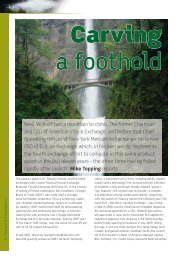Sub-custodian Risk Monitoring: - Financial Services Research
Sub-custodian Risk Monitoring: - Financial Services Research
Sub-custodian Risk Monitoring: - Financial Services Research
- No tags were found...
You also want an ePaper? Increase the reach of your titles
YUMPU automatically turns print PDFs into web optimized ePapers that Google loves.
<strong>Sub</strong>-<strong>custodian</strong> riskture and organisational coverage of itsnetwork management department. It nowhas network staff situated in four centresof excellence globally, located in Toronto,London, Luxembourg and Singapore. This arrangementprovides global network supportfor RBC Dexia’s business 24 hours per day,ensuring that network staff remain close tosub-<strong>custodian</strong>s, to local market infrastructureand to clients. This allows the network managementteam to react promptly to any riskconcerns that may develop at market level.Overarching these provisions, RBC Dexianetwork management department has amethodology in place that it has labelledContinuous <strong>Risk</strong> Assessment (CRA). “Thekey word in this title is continuous,” explainsRichard Barker. “<strong>Sub</strong>-<strong>custodian</strong> risk monitoringis something that we do on a regularand ongoing basis.” The CRA model isapplied across the 88 markets in which RBCDexia supports and safeguards client assetsFrom a sub-<strong>custodian</strong> standpoint, ColinBrooks, Global Head of <strong>Sub</strong>-Custody andClearing at HSBC Securities <strong>Services</strong>, haswitnessed an enhanced focus on sub<strong>custodian</strong>risk monitoring in many guises.“This is apparent when we receive adue diligence visit, or we are required tocomplete a due diligence questionnaire oran RFP,” he says. “In each case, we havenoted a rise in the level of detail requiredby these risk assessments. Our clients areseeking additional detail around how wereconcile trade and holdings informationwith clearing houses and depositories. Theyare seeking detailed information regardingour financial stability; and the businesscontinuity planning arrangements that wehave in place. And, they are requestingcomprehensive information regarding howassets are held in the local market, how titleis transferred and whether they will retainaccess to those assets if a sub-<strong>custodian</strong> orinfrastructure entity passes into insolvency.”In our mind, due diligence is something that happens every day. When we do conduct on-site duediligence, much of our analysis is a verification of the due diligence that we have been conducting,on a daily basis, throughout the year.42 <strong>Financial</strong> <strong>Services</strong> <strong>Research</strong> Q4 2010and across approximately 130 sub-<strong>custodian</strong>relationships. “The CRA model is undertakenin many ways, including remote and on sitedue diligence,” he adds. “One of the cardinalrules around which our asset protectionmethodology is built is that it is obligatoryfor all providers to accept and agree with theCRA process.” The CRA model has six mainsegments – namely legal, sub-<strong>custodian</strong> relationships,market information, operations,financial and risk management – and underlyingthese six headline categories there areapproximately 30 different risk criteria thatare monitored on a continuing basis.In line with this methodology, RBC Dexiahas taken the decision to expand its surveillanceand to eventually bring all cash relationshipsand prime brokerage relationshipsunder the CRA model. As a result, thesebusiness relationships will be monitored onan ongoing basis according to the samerisk assessment methodology applied for itssecurities services and funds businesses.Not only has the depth of questioning increasedwithin these risk reviews, but HSBChas noted greater intensity in the followup process. “In times past, often it was thecase that we would receive a due diligencequestionnaire or RFP, we would respond tothose questions, and typically this would satisfythe requirements of the risk evaluation,”says Brooks. “Now, the depth of analysisand follow up has moved to a higher level.Clients are analysing our responses morecarefully and they will come back to us fordetailed follow up driven by questions fromthe broad range of experts represented onthe organisation’s risk committee.”Broker-dealer customers have long beenrigorous in compiling a real-time view of theexposure that they have to their counterparts.This will include prompt and comprehensivereporting relating to failed tradesand unmatched positions – thereby enablingthem to maintain an accurate picture oftheir cash positions on an intra-day basis.



